.
8.05.2016
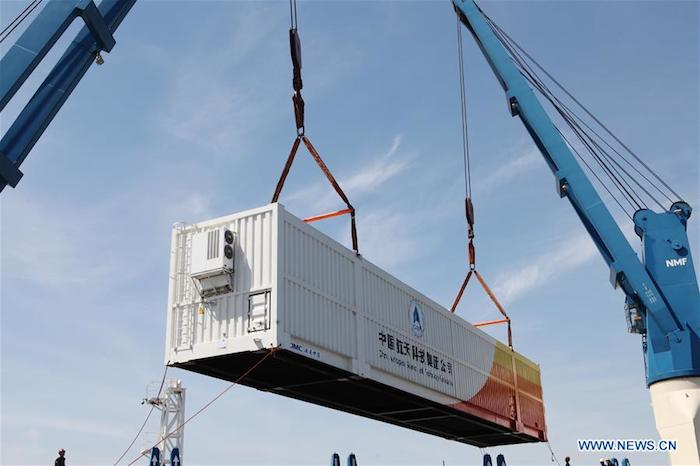
TIANJIN,-- A container carrying China's new-generation Long March-7 rocket is lifted at the port in north China's Tianjin, May 7, 2016. The Long March-7 rocket departed for its launch base in Hainan on Sunday from Tianjin. It has taken researchers eight years to develop the medium-sized rocket, which can carry up to 13.5 tonnes to low Earth orbit, said Li Hong, director of the Carrier Rocket Technology Research Institute with the China Aerospace Science and Technology Corporation.

China's new-generation Long March-7 rocket departed for its launch base in Hainan on Sunday from north China's port of Tianjin.
It has taken researchers eight years to develop the medium-sized rocket, which can carry up to 13.5 tonnes to low Earth orbit, said Li Hong, director of the Carrier Rocket Technology Research Institute with the China Aerospace Science and Technology Corporation.
"The Long March-7 launch scheduled for late June will be of great significance as it will usher in China's space lab mission," said Yang Baohua, deputy manager of the company.
China also plans to launch the heavy lift Long March-5 to transport cargo for the planned space station.
China's second orbiting space lab, Tiangong-2, will also be launched this fall, and it is scheduled to dock with manned spacecraft Shenzhou-11 in the fourth quarter.
Yang said that the Long March-7 carrier is more environmentally friendly than earlier Long March models. The rocket will become the main carrier for space launches.
.

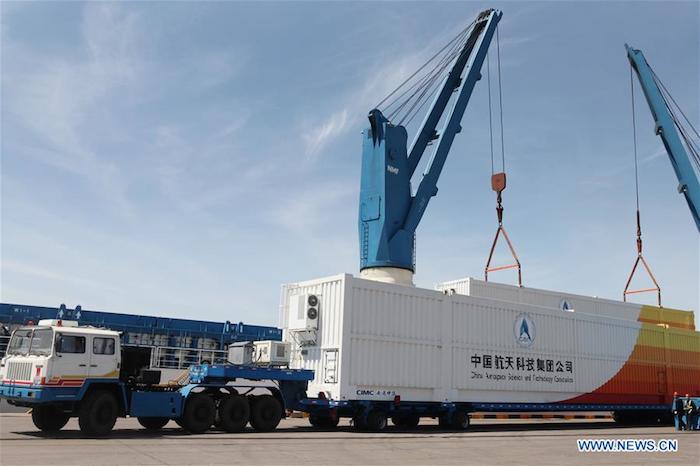
Quelle: Xinhua
.
Update: 9.05.2016
.
China's Long March 7 rocket is on its way to launch site
China's next-generation Long March 7 rocket has departed for the Wenchang Space Launch Centre ahead of its debut space flight next month.
Li Hong of China Aerospace Science and Technology Corporation (CASC), the main contractor for the Chinese space program, told Chinese state media that the medium-sized rocket took eight years to develop and is capable of carrying up to 13.5 tonnes to low Earth orbit.
The first flight of the 53-metre-tall Long March 7 will take place in late June, according to CASC’s Yang Baohua, and will test the design and performance indicators.
.
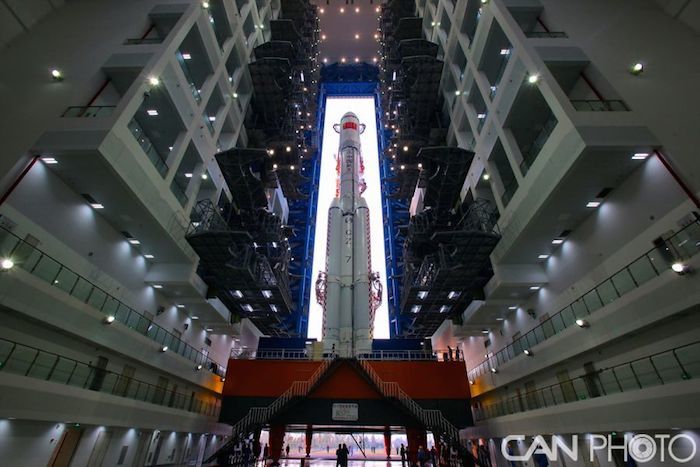
Above: Long March 7 (courtesy of China Aviation News/Huang Zengguang).
-
The 600 tonne, 3.35m diameter rocket will carry a scaled-down version of a new Chinese re-entry capsule for human spaceflight, chief designer of China's human space program Zhou Jianping revealed in March.
The capsule is part of work to develop two next-generation multi-purpose crewed spacecraft, believed to have masses of around 14 and 20 tonnes respectively, as China looks to step up its space exploration capabilities.
.
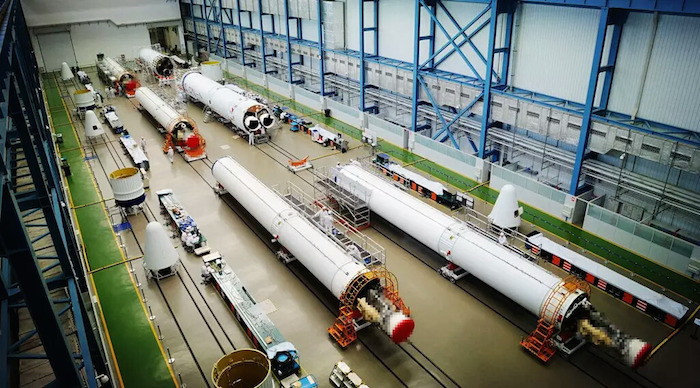
Above: Long March 7 components being manufactured in Tianjin (CASC).
-
The Long March 7 has been designed to launch cargo resupply ships - named Tianzhou - to the future Chinese space station.
The core module of the space station will be launched by the heavy-lift Long March 5, another next-generation rocket which is by far the country’s largest. It is expected to make its maiden flight in September or October.
Once proven, the Long March 7 and its variants are expected to become the main launch vehicle for Chinese space missions, replacing the likes of the Long March 3B.
The first Long March 7 rocket for flight was manufactured in the port city of Tianjin in north China and is being transported by the specially-designed Yuan Wang 21 ship.
Lower launch costs
Professor Huang Jun at the Beijing University of Aeronautics and Astronautics told gbtimes last year that this new generation of Chinese launch vehicle series uses universal modularised design which can be easily combined into new rocket variants for various missions.
“The reliability and launch preparation time are improved and the launching cost will be lowered,” Huang said.
While China’s current Long March series rockets are fuelled by highly toxic hydrazine propellant, the new Long March 5, 6 and 7 launch vehicles mainly use a mix of kerosene and liquid oxygen to reach orbit.
The new propellant, also used by the SpaceX Falcon 9, provides greater specific impulse, with the by-products being water and carbon dioxide.
The coastal location of the new Wenchang Space Launch Centre allows the new, large launch vehicles to be delivered by sea from Tianjin.
China’s rail system, which is used to transport the established Long March rockets to the three interior launch centres, would be unable to cope with the new 5m diameter Long March 5 and 3.35m Long March 7.
Due to the Hainan climate, the Long March 5 and 7 have been designed to be able to launch despite moderate rain.
.
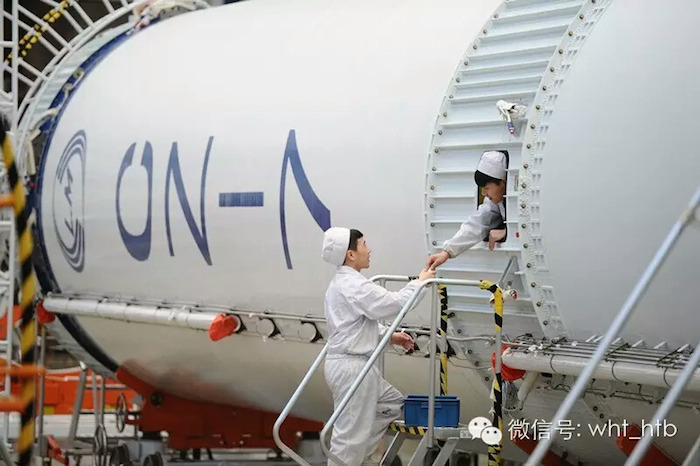
Above: Long March 7 manufacture in Tianjin in February 2016 (CASC).
-
Orbital launches from Wenchang will take advantage of the Earth’s greater rotational speed at lower latitudes compared with China’s other bases, which in effect lowers fuel requirements.
Moving some launches over the sea also means less incidents of space debris raining down on inhabited areas.
The centre took six years to construct at a cost of an estimated five billion yuan (US$800 million) and is another crucial component in China’s plans.
Quelle: gbtimes
.
Update: 19.05.2016
.
China to debut new rocket and spaceport next month
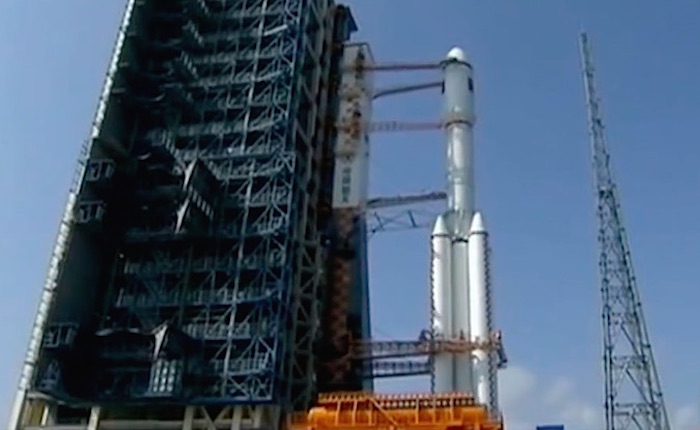
A ground model of China’s new Long March 7 rocket passed a test campaign at the Wenchang space base last year. Credit: CCTV
-
China plans to launch its first Long March 7 rocket, a new kerosene-fueled booster capable of carrying supplies to the country’s planned space station, by the end of June on a test flight that will reportedly loft an unpiloted prototype of a future crew capsule.
The Long March 7’s maiden flight will not only test the new rocket and a next-generation human-rated spacecraft. It will also mark the first use of a new island spaceport in the South China Sea.
Rocket components slated for the Long March 7’s inaugural flight left port at Tianjin, China, on May 8, heading to the launch base on Hainan Island off China’s southern coast, the official state-run Xinhua news agency reported.
The shipment arrived at Hainan on May 14, according to China Aerospace Science and Technology Corp., the Chinese space program’s government-owned prime contractor.
China is developing a new fleet of launchers to replace its antiquated Long March rockets, which burn a toxic mixture of hydrazine and nitrogen tetroxide propellants. The new rockets consume kerosene and liquid oxygen, a more environmentally friendly combination.
Flights from the Hainan spaceport, named the Wenchang Satellite Launch Center, will drop spent rocket stages over the ocean instead of on land. Built between 2009 and 2014, the launch center sits at 19 degrees north latitude, closer to the equator than any other Chinese rocket base, giving China better access to place satellites in geostationary orbit.
China also plans to use the new spaceport for interplanetary missions, including the Chang’e 5 robotic lunar probe, which aims to return samples from the moon as soon as next year.
The country’s other launch centers will continue to be the starting points for human spaceflight missions and polar-orbiting satellites.
With the first Long March 7 rocket delivered to its launch base, technicians plan to complete assembly and testing of the rocket ahead of its late June liftoff.
.
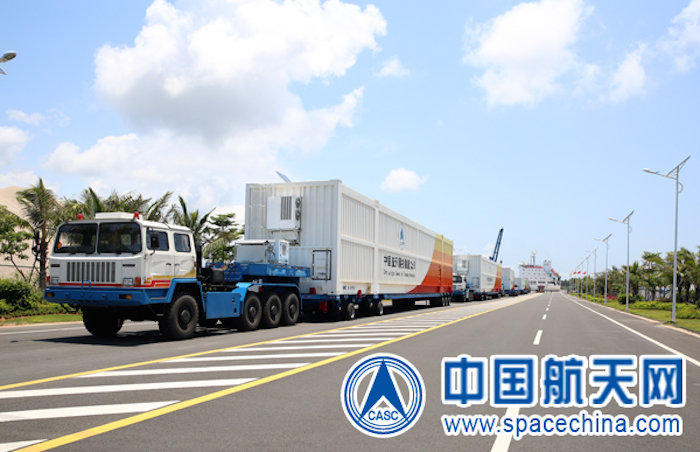
Trucks transport containers with Long March 7 rocket hardware from a port on Hainan Island to the Wenchang Satellite Launch Center last weekend. Credit: CASC
-
Chinese officials said the rocket hardware and ground facilities are in good condition, and everything is on schedule for the Long March 7’s maiden flight next month. Research and development tasks on the medium-class rocket are complete, and engineers successfully put a full-scale model of the Long March 7 through a mock launch campaign at Wenchang last year.
Hotfire tests of the Long March 7’s engines are also complete.
The 53-meter (174-foot-tall) rocket carries four liquid-fueled strap-on boosters, each powered by a single kerosene-fed YF-100 engine. The Long March 7’s first stage is propelled by two of the YF-100 powerplants, each producing about 270,000 pounds of thrust at sea level.
Collectively, the engines will give the rocket more than 1.6 million pounds of thrust at liftoff.
Four smaller YF-115 engines, burning the same kerosene/liquid oxygen mixture, are mounted on the Long March 7’s second stage.
The Long March 7 also features self-monitoring computers and waterproofed components to withstand the wet, tropical conditions at the Wengchang launch base. China’s existing spaceports are located in drier climates.
The main objective of the Long March 7’s first flight is to fully verify the rocket’s design, confirm its performance, and conduct research and space technology tests, according to China Aerospace Science and Technology Corp. or CASC.
.
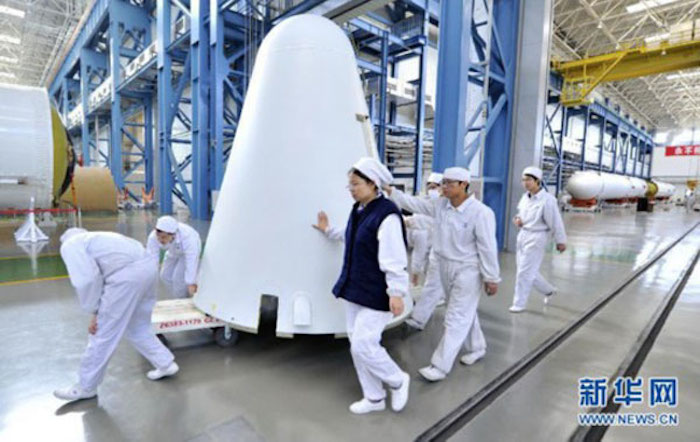
Chinese aerospace technicians are pictured with a nose cone for one of the Long March 7 rocket’s strap-on boosters. Credit: Xinhua
-
The mission will also test a “reduced scale” re-entry vehicle for a future Chinese crew capsule, Xinhua reported in March.
Chinese officials say the Long March 7 can place up to 13.5 metric tons (nearly 30,000 pounds) into low Earth orbit, and 5.5 metric tons (about 12,100 pounds) into a sun-synchronous polar orbit up to 700 kilometers (435 miles) in altitude.
Development of the Long March 7 rocket officially started in 2011, CASC said on its website,
This could be a banner year for China’s space program, with the debut of the Wenchang space center and the Long March 7 planned in June, followed by the maiden flight of the heavy-lift Long March 5 launcher from Wenchang before the end of 2016.
The Long March 5 rocket will loft up to 25 metric tons, or 55,000 pounds, to low Earth orbit, enough to place heavy modules in orbit for China’s planned space station. The heavy-lifter can put up to 14 metric tons, or nearly 31,000 pounds, into geostationary transfer orbit, the destination favored by most communications satellites.
That is roughly equivalent to the capacity of United Launch Alliance’s Delta 4-Heavy rocket, and two-and-a-half times China’s current lift capability.
China plans to replace its current outdated rockets — based on decades-old designs — with a new fleet of Long March 5, 6 and 7 boosters.
The Long March 6 is the smallest of the bunch, capable of catapulting small satellites into low-altitude orbits. It successfully flew for the first time in September 2015, demonstrating the YF-100 engine during a real launch.
China’s next-generation human-tended space lab is set for launch in September, followed in October by the liftoff of the country’s first astronaut mission since 2013. The two-person crew aboard the Shenzhou 11 spacecraft will visit the newly-launched Tiangong 2 laboratory and stay in orbit for 30 days, China’s longest-duration space mission to date.
Tiangong 2 will receive China’s first automated Tianzhou space station supply ship, which will deliver cargo and fuel, filling the role of Russia’s Progress freighter.
The Tianzhou cargo ships will be regular payloads on Long March 7 rockets to service China’s space station, an orbiting research lab planned for completion around 2020.
Quelle: SN
-
Update: 22.06.2016
.
China to launch new carrier rocket June 25-29
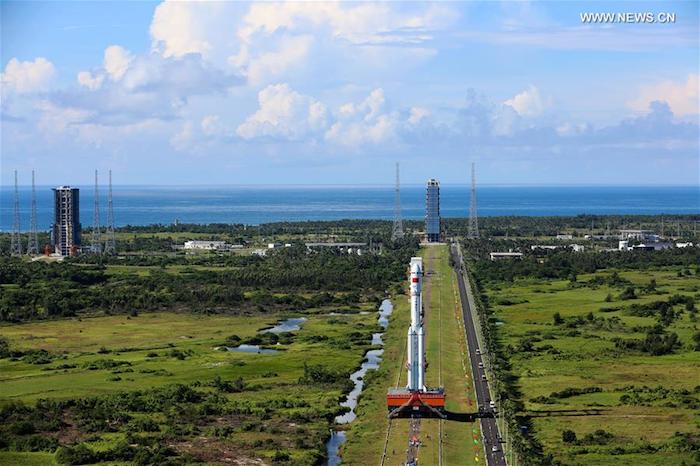
WENCHANG, June 22, 2016 (Long March-7 carrier rocket is transferred vertically to the launch pad in Wenchang, south China's Hainan Province, June 22, 2016. China plans to launch its new generation Long March-7 carrier rocket between Saturday and Wednesday from a new launch ground in Wenchang. The Long March-7 is a medium-sized rocket using liquid propellant that can carry up to 13.5 tonnes to low-Earth orbit. It will transport cargo for China's planned space station and is expected to become the main carrier for space launches. (Xinhua/Zeng Tao)
WENCHANG, Hainan, June 22 (Xinhua) -- China plans to launch its new generation Long March-7 carrier rocket between Saturday and Wednesday from a new launch ground in south China, according to the manned space engineering office on Wednesday.
The rocket was vertical when taken to the launch pad in journey that took three hours this morning.
The Long March-7 is a medium-sized rocket using liquid propellant that can carry up to 13.5 tonnes to low-Earth orbit. It will transport cargo for China's planned space station and is expected to become the main carrier for space launches.
The rocket arrived at Wenchang in south China's Hainan Province in May for final assembly and testing.
This will be the first launch from Wenchang, the fourth launch site in China. Its construction was completed in November 2014.
According to the local tourism department, all hotels are fully booked until Sunday. The city can only provide accommodation for 80,000 people and suggested tourists avoid the maiden launch, as there will be more in the future.
.
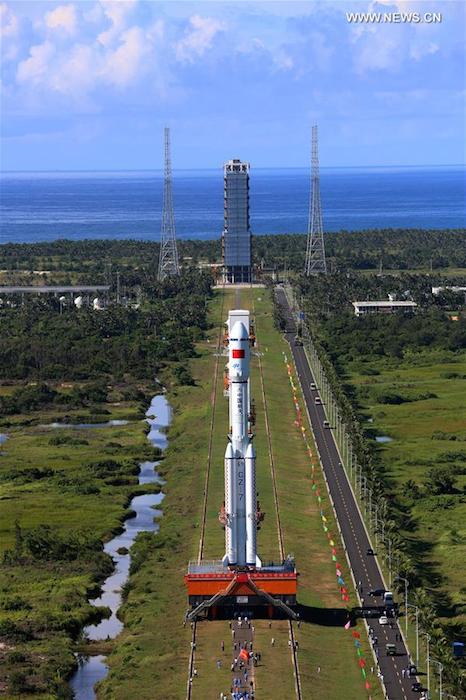
Long March-7 carrier rocket is transferred vertically to the launch pad in Wenchang, south China's Hainan Province, June 22, 2016. China plans to launch its new generation Long March-7 carrier rocket between Saturday and Wednesday from a new launch ground in Wenchang. The Long March-7 is a medium-sized rocket using liquid propellant that can carry up to 13.5 tonnes to low-Earth orbit. It will transport cargo for China's planned space station and is expected to become the main carrier for space launches. (Xinhua/Zeng Tao)
.
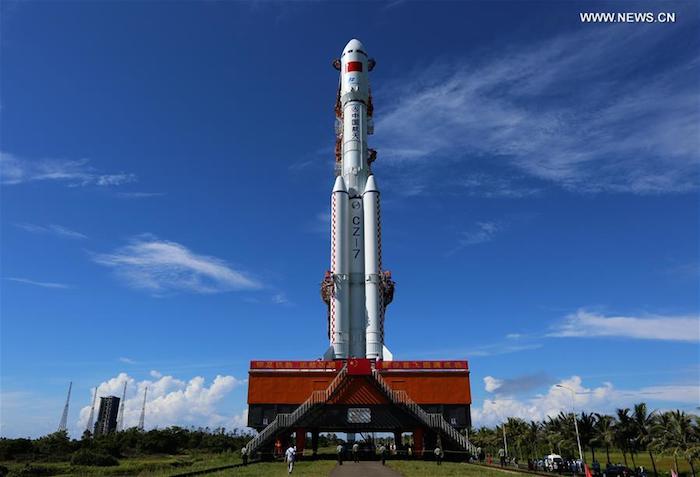
Long March-7 carrier rocket is transferred vertically to the launch pad in Wenchang, south China's Hainan Province, June 22, 2016. China plans to launch its new generation Long March-7 carrier rocket between Saturday and Wednesday from a new launch ground in Wenchang. The Long March-7 is a medium-sized rocket using liquid propellant that can carry up to 13.5 tonnes to low-Earth orbit. It will transport cargo for China's planned space station and is expected to become the main carrier for space launches. (Xinhua/Zeng Tao)
.
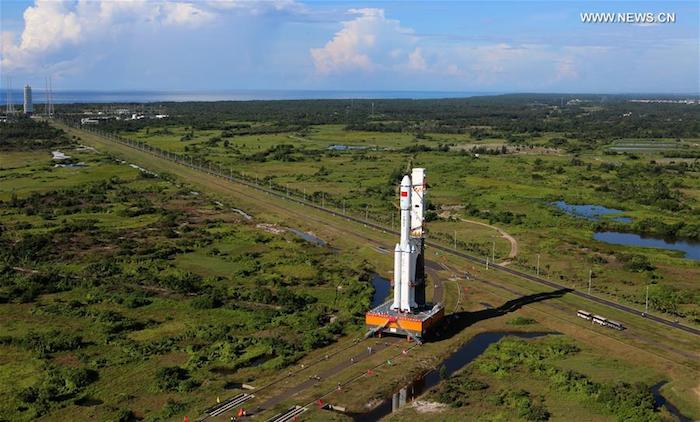
Long March-7 carrier rocket is transferred vertically to the launch pad in Wenchang, south China's Hainan Province, June 22, 2016. China plans to launch its new generation Long March-7 carrier rocket between Saturday and Wednesday from a new launch ground in Wenchang. The Long March-7 is a medium-sized rocket using liquid propellant that can carry up to 13.5 tonnes to low-Earth orbit. It will transport cargo for China's planned space station and is expected to become the main carrier for space launches. (Xinhua/Zeng Tao)
.
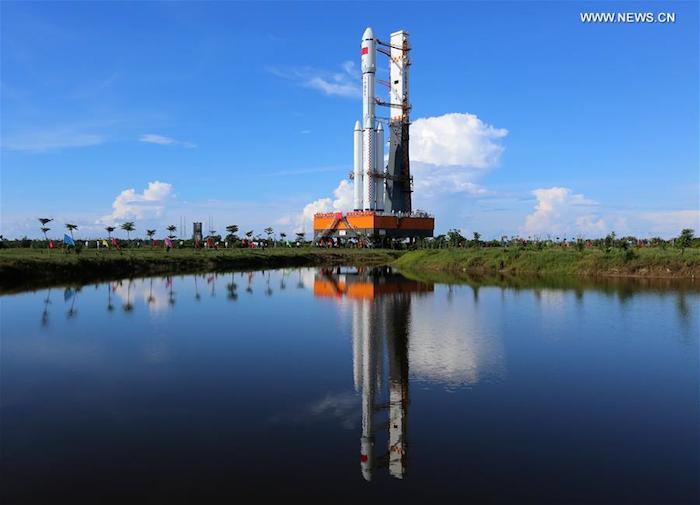
Long March-7 carrier rocket is transferred vertically to the launch pad in Wenchang, south China's Hainan Province, June 22, 2016. China plans to launch its new generation Long March-7 carrier rocket between Saturday and Wednesday from a new launch ground in Wenchang. The Long March-7 is a medium-sized rocket using liquid propellant that can carry up to 13.5 tonnes to low-Earth orbit. It will transport cargo for China's planned space station and is expected to become the main carrier for space launches. (Xinhua/Zeng Tao)
.

Long March-7 carrier rocket is transferred vertically to the launch pad in Wenchang, south China's Hainan Province, June 22, 2016. China plans to launch its new generation Long March-7 carrier rocket between Saturday and Wednesday from a new launch ground in Wenchang. The Long March-7 is a medium-sized rocket using liquid propellant that can carry up to 13.5 tonnes to low-Earth orbit. It will transport cargo for China's planned space station and is expected to become the main carrier for space launches. (Xinhua/Zeng Tao)
Quelle: Xinhua
---
China’s newest space rocket, Long March 7, ready for blast-off
Public will be allowed for the first time to watch the lift-off from viewing areas around Wenchang Satellite Launch Centre on Hainan
China’s latest Long March rocket arrived on the launch pad on Wednesday morning on Hainan island three days before the scheduled maiden mission of both the rocket and the site.
This launch will be different from others carried out by China because the public will be able to view it in person for the first time.
Eight designated viewing areas covering 40 hectares have been chosen around the Wenchang Satellite Launch Centre, including public parks and a private hotel beach, and can accommodate about 25,000 spectators.
China Central Television (CCTV) revealed the launch window of the Long March 7 would be open until Wednesday if Saturday’s weather turned bad, which is not uncommon on tropical Hainan.
CCTV said the 600-tonne rocket began the three-hour rail journey of several kilometres from the assembly complex to the launch site.
It will be carrying a test model of China’s next-generation manned spacecraft, together with several small satellites. The rocket’s future role will be to deliver supplies to China’s planned space station.
“The launch will open a new chapter in the history of Chinese space exploration,” a space scientist involved in the development of the new Long March rockets said.
“The blast of flames, rise of vapour, the chest-pounding noise and the trembling of the ground under people’s feet ... it will be a life-changing experience for many people.”
Wenchang is one of four space launch centres in China. The Jiuquan satellite launch centre is located in the heart of the Gobi desert, while Xichang is hidden away in the remote mountains of Sichuan.
The site at Taiyuan, in Shanxi, remains closed to the public for most of its launches owing to military operations.
Mainland space scientists had first proposed setting up a space launch centre in Hainan decades ago. Because the island lies closer to the equator, it can save fuel consumption by more than 10 per cent compared with the other launch sites.
It is also convenient because the large rocket components can be transported easily by ship from China’s rocket manufacturing centre in Tianjin to Hainan, while rocket debris will fall into the ocean instead of over populated inland areas.
However, the government delayed the plan because of fears that Hainan could be an easy target for a foreign invasion.
The island’s tropical weather, which includes frequent typhoons, and technical concerns over humidity and salt erosion added to the authorities’ concerns.
The Wenchang satellite launch centre will play a critical role in many of China’s future space activities, such as the building of a space station, which is due to be completed in about 2020.
Quelle: South China Morning Post
-
Update: 25.06.2016
-
China launches new generation carrier rocket
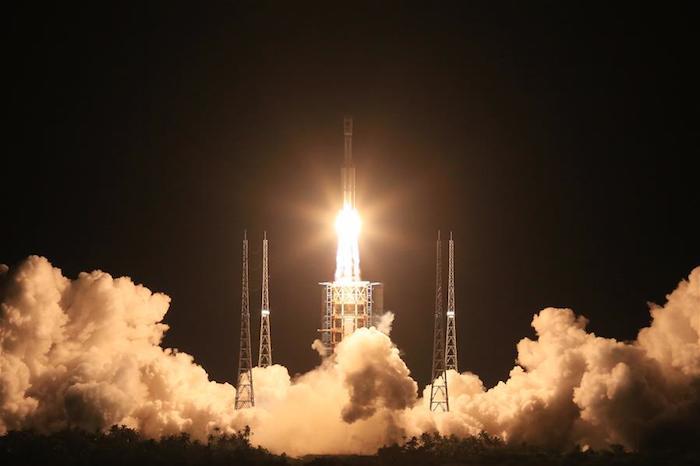
WENCHANG, June 25, 2016 A Long March-7 carrier rocket lifts off from Wenchang Satellite Launch Center, south China's Hainan Province, June 25, 2016. (Xinhua/Li Gang)
WENCHANG, Hainan, June 25 China on Saturday successfully blasted off its new generation carrier rocket Long March-7 from a new space launch center in Wenchang, Hainan province.
In a cloud of white smoke, the rocket, carrying a scaled-down version of "a reentry module of a multi-function spacecraft," ascended against a the dark sky, trailing a vast column of flame.
Wang Hongyao, deputy chief commander of the mission, declared the launch a success minutes later.
He said the rocket's payload separated from the rocket 603 seconds after blast-off, and entered an oval orbit with a low point, or perigee, of 200 kilometers, and a high point, or apogee, of 394 kilometers.
The re-entry module is expected to return to Earth on Sunday afternoon.
The Long March-7 is a medium-sized, two-stage rocket that can carry up to 13.5 tonnes to low-Earth orbit. Experts say it will become the main carrier for China's future space missions.
Earlier reports said the rocket now uses kerosene and liquid oxygen as fuel, rather than the highly toxic propellant, making it more environmental friendly and less expensive.
Saturday's launch is the first by the Wenchang site, and the 230th of China's Long March carrier rocket family.
Its mission is to verify the design and performance of the new carrier rocket, to evaluate mission execution capacity of the Wenchang launch site, and to check coordination and compatibility of project-related systems.
Quelle: Xinhua
----
.
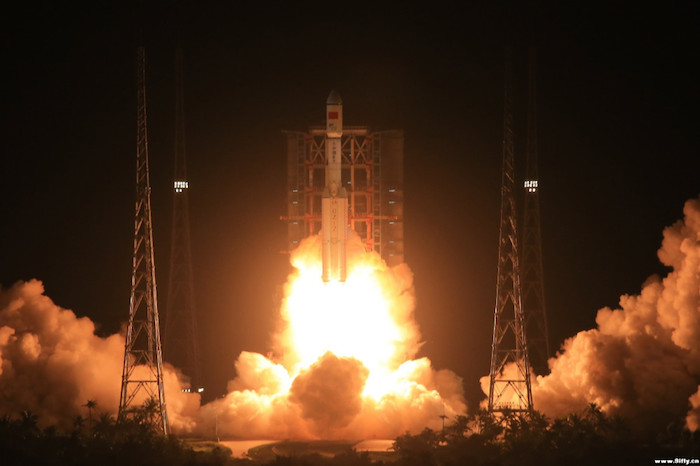
At 20:00:07 local time (12:00:07 UTC) on 25 June 2016, a Chang Zheng-7 (CZ-7, or Long March 7) launch vehicle with a YZ-1A upper stage blasted off from Pad 201 at the China Wenchang Space Centre (CWSC) on Hainan Island in southern China. After 603 seconds of flight, the rocket successfully placed its payloads, including a scaled ballistic capsule for the future next-generation crew vehicle, into a 200 km by 394 km Low Earth Orbit (LEO).
The historical mission came after years-long planning, development, constructing and testing, and marks the beginning of a new era in China’s space endeavour, with the simultaneous introduction of new spacecraft R&D facilities, a new spaceport, and an entire new family of launch vehicles based on common rocket engines. Once fully operational, these new elements will further expand China’s space launch capability, allowing heavier payload including space station modules and deep space probes to be lofted into orbit.
The introduction of the CZ-7 is also an important milestone in China’s effort to build a permanent space station on LEO – an ambitious programme initiated in 1992 and to be implemented in three stages over a timespan of 30 years. The first stage of the plan, with the aim to send human into space aboard the Shenzhou spacecraft vehicle, was concluded in 2006 after four unmanned test flights and two crewed missions. Currently the programme is in its second stage, aimed to develop and perfect advanced spaceflight techniques and technologies required for building an Earth-orbiting space station.
The CZ-7 will initially be used to launch the Tianzhou cargo ship to resupply China’s space station in orbit. However, once its technology matures the launch vehicle will be used to support other launch missions, including a man-rated version to launch the next-generation multi-purpose crew vehicle, which is currently in initial design stage.
The CZ-7 Launch Vehicle
In 2008, China Academy of Launch Vehicle Technology (CALT) revealed that Shenzhou 7 was to be the last mission launched by the basic variant CZ-2F launch vehicle, and two new improved variants were being developed to support follow-up missions in China’s human spaceflight programme – a modestly improved variant the CZ-2F/G featuring a new navigation package, and a radically upgraded variant the CZ-2F/H featuring a newly developed rocket engine burning a bi-propellant with kerosene as fuel and liquid oxygen (LOX) as oxidiser.
While the CZ-2/G entered service in 2011 for the launch of the Tiangong 1 space station module, and the subsequent Shenzhou 8, 9 and 10 missions. The CZ-2F/H project evolved into a completely new design, which was later given a new designation the CZ-7. The launch vehicle will share many technologies originally developed for the CZ-5 heavy-load launch vehicle, and is also built by the new rocket fabrication facility in Tianjin.
The basic variant CZ-7 is in a configuration of two-stage core vehicle with four strap-on liquid rocket boosters, powered by the newly developed YF-100 and YF-115 liquid rocket engines, both burning kerosene as fuel and liquid oxygen (LOX) as oxidiser. Without using an upper stage, the CZ-7 is able to place 13.5 t payload to a 400 km Low Earth Orbit (LEO), or 5.5 t payload to a 700 km Sun Synchronous Orbit (SSO).
Initially the CZ-7 will only be used to launch the Tianzhou cargo ship, but its designers hopes that the launch vehicle will eventually replace most designs in China’s existing Chang Zheng (Long March) launch vehicle family, including the CZ-2 series primarily intended for LEO missions from Jiuquan, the CZ-3 series for GEO missions from Xichang, and the CZ-4 series for SSO missions from Taiyuan. However, the launch vehicle will face some fierce competitions from its rivals, including the heavier CZ-5 from the same designer, and the (potentially more flexible) CZ-6A proposed by the Shanghai-based SAST.
The Launch Pad
Pad 201, from which the CZ-7 took off, is one of the two launch pads in the newly constructed Wenchang Space Launch Centre. Construction of the launch centre began in September 2009, and the launch complex facilities including launch pads, mobile launcher platforms, and vehicle assembly buildings became operational in 2014. A month-long simulated CZ-7 launch campaign using a non-flying ground test vehicle was conducted in late 2014.
The launch vehicle is delivered in segments by a specially designed Yuan Wang seagoing cargo ship from Tianjin on the east coast of China mainland to the Port of Qinglan on Hainan Island, where the segments are then transported by road to the launch centre. The segments are first examined in the horizontal checkout building, before being assembled and integrated with the payloads inside the 15-storey, 99.4 m-high steel-reinforced concrete Vehicle Assembly Building (VAB). Days before the launch, the assembled launch vehicle stack is rolled out in a vertical position atop a Mobile Launcher Platform, which moves on a rail track between the VAB and launch pad.
At the pad are a fixed umbilical tower, underground flame deflector trenches and ducts, and four lightning rods. Once the Mobile Launcher Platform carrying the launch vehicle stack arrives at the pad, the umbilical tower will move its swing arms and rotating platforms to embrace the vehicle, to allow the ground crew to inspect vehicle and carry out fuelling operation. The launch pads at Wenchang are the first in China to feature the Sound Suppression System, which sprays large volumes of water over the launcher platform and into the flame deflector trenches below it to dampen sound waves generated by the rocket engines, and also discouraged fires that might be caused by the rocket exhaust.
Future Missions
The CZ-7 test launch mission is only the first of a series of high-profile launch missions planned to take off from Wenchang over the next few years:
The heavier CZ-5 launch vehicle is due to make its debut flight in late September or early October this year;
A second CZ-7 launch is scheduled for early 2017, carrying China’s first cargo ship Tianzhou 1 for a test resupply mission with the Tiangong 2 laboratory module;
The Chang’e 5 lunar sample return mission is due to be launched by a CZ-5 in the second-half of 2017;
The CZ-5B will launch Tianhe 1, the core module of the Chinese Space Station, in 2018, followed by two laboratory modules and a space telescope module, all using the CZ-5B, between 2018 and 2022;
Quelle: CSR
5136 Views
